Mechanical Properties of the Pt-CNT Composite under Uniaxial Deformation: Tension and Compression
Abstract
:1. Introduction
2. Materials and Methods
3. Results and Discussion
3.1. The Role of the CNT Diameter
3.2. The Role of the CNT Number in the Model
3.3. Destruction Mechanism
4. Conclusions
Author Contributions
Funding
Institutional Review Board Statement
Informed Consent Statement
Data Availability Statement
Acknowledgments
Conflicts of Interest
References
- Brigante, D. New Composite Materials Selection, Design, and Application; Springer International Publishing: Cham, Switzerland, 2014; ISBN 978-3-319-01636-8. [Google Scholar] [CrossRef]
- Samuel, C.S.J.; Suresh, M.; Gnanasekaran, S. Functional Composite Materials: Manufacturing Technology and Experimental Application; Bentham Science Publishers Pte. Ltd.: Singapore, 2022. [Google Scholar] [CrossRef]
- Zhou, C.; Gan, M.; Xie, F.; Ma, L.; Ding, J.; Shen, J.; Han, S.; Wei, D.; Zhan, W. Pt nanoparticles coated on multiwalled carbon nanotubes by the modification of small-sized molybdenum phosphide for enhanced methanol electro-oxidation. Ionics 2020, 26, 6331–6340. [Google Scholar] [CrossRef]
- Themsirimongkon, S.; Pongpichayakul, N.; Fang, L.; Jakmunee, J.; Saipanya, S. New catalytic designs of Pt on carbon nanotube-nickel-carbon black for enhancement of methanol and formic acid oxidation. J. Electroanal. Chem. 2020, 876, 114518. [Google Scholar] [CrossRef]
- Mercado-Zúñiga, C.; Oliva, J.; Vargas-García, J.R.; Diaz-Torres, L.A.; Gomez-Solis, C. Effect of Pt loading on the hydrogen production of CNT/Pt composites functionalized with carboxylic groups. Int. J. Hydrog. Energy 2020, 45, 27012–27025. [Google Scholar] [CrossRef]
- Tiwari, S.K.; Singh, H.; Midathada, A.; Sharma, S.; Ravella, U.K. Study of Fabrication Processes and Properties of Al-CNT Composites Reinforced by Carbon Nano tubes-A Review. Mater. Today Proc. 2018, 5, 28262–28270. [Google Scholar] [CrossRef]
- Aristizabal, K.; Katzensteiner, A.; Bachmaier, A.; Mücklich, F.; Suárez, S. Microstructural evolution during heating of CNT/Metal Matrix Composites processed by Severe Plastic Deformation. Sci. Rep. 2020, 10, 857. [Google Scholar] [CrossRef]
- Katzensteiner, A.; Müller, T.; Kormout, K.; Aristizabal, K.; Suarez, S.; Pippan, R.; Bachmaier, A. Influence of Processing Parameters on the Mechanical Properties of HPT-Deformed Nickel/Carbon Nanotube Composites. Adv. Eng. Mater. 2019, 21, 1800422. [Google Scholar] [CrossRef]
- Borkar, T.; Mohseni, H.; Hwang, J.; Scharf, T.; Tiley, J.; Hong, S.H.; Banerjee, R. Spark plasma sintering (SPS) of carbon nanotube (CNT)/graphene nanoplatelet (GNP)-nickel nanocomposites: Structure property analysis. In Advanced Composites for Aerospace, Marine, and Land Applications II; Springer: Berlin/Heidelberg, Germany, 2016; pp. 53–79. [Google Scholar] [CrossRef]
- Wang, M.; Yang, X.; Tao, J.; Bu, Y.; Liu, Y.; Pu, Z.; Yi, J. Achieving high ductility in layered carbon nanotube/copper composite prepared by composite electrodeposition. Diam. Relat. Mater. 2020, 108, 107992. [Google Scholar] [CrossRef]
- Abdullahi, U.; Maleque, M.A.; Ali, M.Y. Hardness behaviour of carbon nanotube-aluminium nano-composite using nanoindentation technique. Mater. Today Proc. 2019, 46, 6097–6101. [Google Scholar] [CrossRef]
- Rao, P.K.V.; RaghuKumar, B.; Veera Sai Chandh, Y.; Teja, A. Finite element analysis of CNT reinforced aluminium composite subjected to mechanical loading. Mater. Today Proc. 2019, 16, 308–313. [Google Scholar] [CrossRef]
- Fukuchi, K.; Sasaki, K.; Katagiri, K.; Imanishi, T.; Kakitsuji, A. Aluminium based high thermal conductive composites containing CNT and VGCF-deformation dependence of thermal conductivity. Procedia Eng. 2011, 10, 912–917. [Google Scholar] [CrossRef]
- Mansoor, M.; Shahid, M. Fractographic evaluation of crack initiation and growth in Al-CNTs nanocomposite fabricated by induction melting. Acta Phys. Pol. A 2015, 128, 276–278. [Google Scholar] [CrossRef]
- Doering, M.; Kieninger, J.; Urban, G.A.; Weltin, A. Electrochemical microelectrode degradation monitoring: In situ investigation of platinum corrosion at neutral pH. J. Neural Eng. 2022, 19, 016005. [Google Scholar] [CrossRef] [PubMed]
- Luitz, M.; Lunzer, M.; Mader, M.; Kotz-Helmer, F.; Rapp, B.E. Fabrication of platinum microstructures for sensors and lab-on-a-chip devices. Prog. Biomed. Opt. Imaging-Proc. SPIE 2022, 11955, 119550D. [Google Scholar] [CrossRef]
- Nanbakhsh, K.; Ritasalo, R.; Serdijn, W.A.; Giagka, V. Long-term Encapsulation of Platinum Metallization Using a HfO2 ALD-PDMS Bilayer for Non-hermetic Active Implants. In Proceedings of the 2020 IEEE 70th Electronic Components and Technology Conference (ECTC), Orlando, FL, USA, 3–30 June 2020; pp. 467–472. [Google Scholar] [CrossRef]
- Nanbakhsh, K.; Kluba, M.; Pahl, B.; Bourgeois, F.; Dekker, R.; Serdijn, W.; Giagka, V. Effect of Signals on the Encapsulation Performance of Parylene Coated Platinum Tracks for Active Medical Implants. In Proceedings of the Annual International Conference of the IEEE Engineering in Medicine and Biology Society, EMBS 2019, Berlin, Germany, 23–27 July 2019; Volume 8857702, pp. 3840–3844. [Google Scholar] [CrossRef]
- Harris, A.R.; Newbold, C.; Carter, P.; Cowan, R.; Wallace, G.G. Using chronopotentiometry to better characterize the charge injection mechanisms of platinum electrodes used in bionic devices. Front. Neurosci. 2019, 13, 380. [Google Scholar] [CrossRef]
- Elena della Valle, E.; Koo, B.; Patel, P.R.; Whitsitt, Q.; Purcell, E.K.; Chestek, C.A.; Weiland, J.D. Electrodeposited Platinum Iridium Enables Microstimulation with Carbon Fiber Electrodes. Front. Nanotechnol. 2021, 3, 782883. [Google Scholar] [CrossRef]
- Gonzalez-Gonzalez, M.A.; Bendale, G.S.; Wang, K.; Wallace, G.G.; Romero-Ortega, M. Platinized graphene fiber electrodes uncover direct spleen-vagus communication. Commun. Biol. 2021, 4, 1097. [Google Scholar] [CrossRef] [PubMed]
- Yoon, E.J.; Stelson, A.C.; Orloff, N.D.; Long, C.J.; Booth, J.C.; Meng, E.F. The Effect of Annealing Thin Film Parylene C-Platinum Interfaces Characterized by Broadband Dielectric Spectroscopy. In Proceedings of the 21st International Conference on Solid-State Sensors, Actuators and Microsystems, Transducers 2021, Orlando, FL, USA, 20–24 June 2021; pp. 884–887. [Google Scholar] [CrossRef]
- Burblies, N.; Schulze, J.; Schwarz, H.-C.; Kranz, K.; Motz, D.; Vogt, C.; Lenarz, T.; Warnecke, A.; Behrens, P. Coatings of different carbon nanotubes on platinum electrodes for neuronal devices: Preparation, cytocompatibility and interaction with spiral ganglion cells. PLoS ONE 2016, 11, e0158571. [Google Scholar] [CrossRef] [PubMed]
- Yu, L.; Li, D.; Xu, Z.; Zheng, S. Polyaniline coated Pt/CNT as highly stable and active catalyst for catalytic hydrogenation reduction of Cr(VI). Chemosphere 2023, 310, 136685. [Google Scholar] [CrossRef]
- Naguib, H.M.; Taha, E.O.; Ahmed, M.A.; Kandil, U.F. Kandil Enhanced wooden polymer composites based on polyethylene and nano-modified wooden flour. Egypt. J. Pet. 2022, 31, 39–45. [Google Scholar] [CrossRef]
- Lee, W.; Jang, S.; Kim, M.J.; Myoung, J.M. Interfacial interactions and dispersion relations in carbon–aluminum nanocomposite systems. Nanotechnology 2008, 19, 285701. [Google Scholar] [CrossRef]
- Wang, L.; Zhang, H.W.; Deng, X.M. The influence of tube length, radius and chirality on the buckling behavior of single-walled carbon nanotubes filled with copper atoms. J. Phys. Condens. Matter 2009, 21, 305301. [Google Scholar] [CrossRef] [PubMed]
- Guo, S.H.; Zhu, B.E.; Ou, X.D.; Pan, Z.Y.; Wang, Y.X. Deformation of goldfilled single-walled carbon nanotubes under axial compression. Carbon 2010, 48, 4129–4135. [Google Scholar] [CrossRef]
- Song, H.-Y.; Zha, X.-W. Molecular dynamics study of effects of nickel coating on torsional behavior of single-walled carbon nanotube. Phys. B Condens. Matter 2011, 406, 92–995. [Google Scholar] [CrossRef]
- Zhang, L.; Zhu, Y.; Li, N.; Rong, Y.; Xia, H.; Ma, H. Atomistic simulation of Al-graphene thin film growth on polycrystalline Al substrate. Appl. Surf. Sci. 2018, 433, 540–545. [Google Scholar] [CrossRef]
- Yazdandoost, F.; Boroujeni, A.Y.; Mirzaeifa, R. Nanocrystalline nickelgraphene nanoplatelets composite: Superior mechanical properties and mechanics of properties enhancement at the atomistic level. Phys. Rev. Mat. 2017, 1, 076001. [Google Scholar]
- Montazeri, A.; Panahi, B. MDbased estimates of enhanced load transfer in graphene/metal nanocomposites through Ni coating. Appl. Surf. Sci. 2017, 457, 1072–1080. [Google Scholar] [CrossRef]
- Kumar, S. Graphene engendered 2-D structural morphology of aluminium atoms: Molecular dynamics simulation study. Mater. Chem. Phys. 2017, 202, 329–339. [Google Scholar] [CrossRef]
- Roman, R.; Cranford, S. Strength and Toughness of Graphdiyne/Copper Nanocomposites. Adv. Eng. Mater. 2014, 16, 862–871. [Google Scholar] [CrossRef]
- Song, H.Y.; Zha, X.W. Influence of nickel coating on the interfacial bonding characteristics of carbon nanotube–aluminum composites. Comput. Mater Sci. 2010, 49, 899–903. [Google Scholar] [CrossRef]
- Silvestre, N.; Faria, B.; Canongia Lopes, J.N. Compressive behavior of CNT-reinforced aluminum composites using molecular dynamics. Compos. Sci. Technol. 2014, 90, 16–24. [Google Scholar] [CrossRef]
- Atomsk: A tool for manipulating and converting atomic data files Pierre Hirel. Comput. Phys. Comm. 2015, 197, 212–219. [CrossRef]
- LAMMPS Molecular Dynamics Simulator. Available online: http://lammps.sandia.gov/ (accessed on 17 August 2022).
- Shelepev, I.A.; Bayazitov, A.M.; Korznikova, E.A. Modeling of supersonic crowdion clusters in FCC lattice: Effect of the interatomic potential. J. Micromechanics Mol. Phys. 2021, 6, 2050019. [Google Scholar] [CrossRef]
- Kolesnikov, I.D.; Shepelev, I.A. Excitation and propagation of 1-crowdion in bcc niobium lattice. Materials. Technologies. Des. 2022, 4, 5–10. [Google Scholar] [CrossRef]
- Chetverikov, A.P.; Shepelev, I.A.; Korznikova, E.A.; Kistanov, A.A.; Dmitriev, S.V.; Velarde, M.G. Breathing subsonic crowdion in Morse lattices. Comput. Condens. Matter 2017, 13, 59–64. [Google Scholar] [CrossRef]
- Shepelev, I.A.; Dmitriev, S.V.; Kudreyko, A.A.; Velarde, M.G.; Korznikova, E.A. Supersonic voidions in 2D Morse lattice. Chaos Solitons Fractals 2020, 140, 110217. [Google Scholar] [CrossRef]
- Yankovskaya, U.I.; Zakharov, P.V. Heat resistance of a Pt crystal reinforce with CNT’s. Materials. Technologies. Des. 2021, 3, 64–67. [Google Scholar] [CrossRef]
- Chen, H.-Y.; Tsou, N.-T. The Analysis of Thermal-Induced Phase Transformation and Microstructural Evolution in Ni-Ti Based Shape Memory Alloys by Molecular Dynamics. Comput. Model. Eng. Sci. 2019, 120, 319–332. [Google Scholar] [CrossRef]
- Yoon, T.; Kang, S.; Yeob Kang, T.; Kim, T.-S. Detection of Graphene Cracks by Electromagnetic Induction, Insensitive to Doping Level. Comput. Model. Eng. Sci. 2019, 120, 351–361. [Google Scholar] [CrossRef]
- Jeong, G.-U.; Lee, B.-J. Interatomic potentials for Pt-C and Pd-C systems and a study of structure-adsorption relationship in large Pt/graphene system. Comput. Mater. Sci. 2020, 185, 109946. [Google Scholar] [CrossRef]
- Stukowski, A. Computational analysis methods in atomistic modeling of crystals. J. Min. Met. Mat. Soc. 2013, 66, 399–407. [Google Scholar] [CrossRef]
- Sankaranarayanan, S.; Bhethanabotla, V.; Joseph, B. Molecular dynamics simulation of temperature and strain rate effects on the elastic properties of bimetallic pd-pt nanowires. Phys. Rev. B 2007, 76, 134117. [Google Scholar] [CrossRef]
- Setoodeh, A.R.; Attariani, H.; Khosrownejad, M. Nickel nanowires under uniaxial loads: A molecular dynamics simulation study. Comput. Mater. Sci. 2008, 44, 78–84. [Google Scholar] [CrossRef]
- Lee, S.; Park, J.; Yang, J.; Lu, W. Molecular dynamics simulations of the traction-separation response at the interface between pvdf binder and graphite in the electrode of li-ion batteries. J. Electrochem. Soc. 2014, 161, A1218–A1223. [Google Scholar] [CrossRef]
- Markidonov, A.V.; Starostenkov, M.D.; Lubyanoi, D.A.; Zakharov, P.V.; Lipunov, V.N. Modeling of Healing Cylindrical Cavities Exposed to Shock Waves in Crystal Subjected to Shear Deformation. Steel Transl. Link Is Disabl. 2022, 52, 208–214. [Google Scholar] [CrossRef]
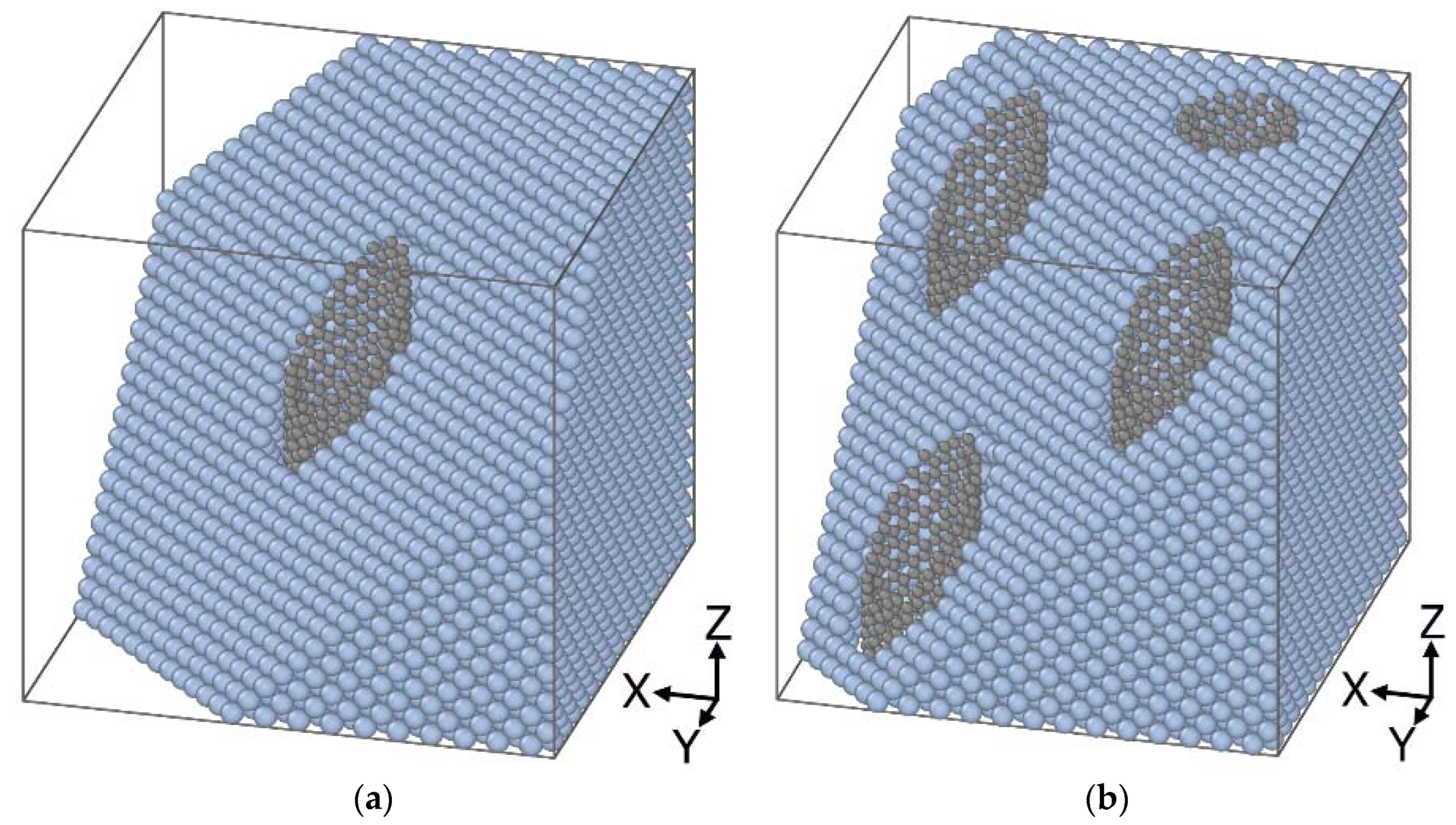

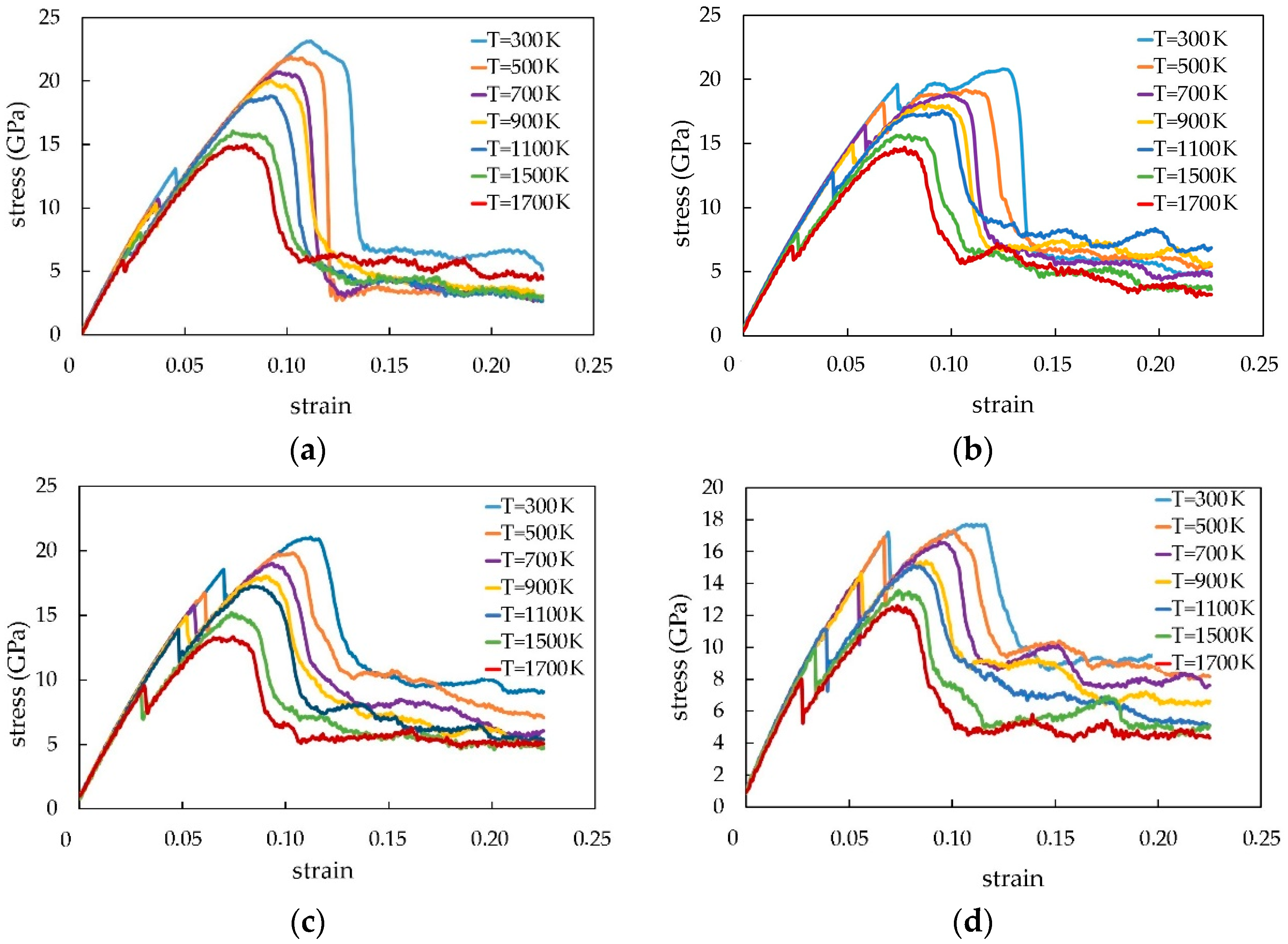
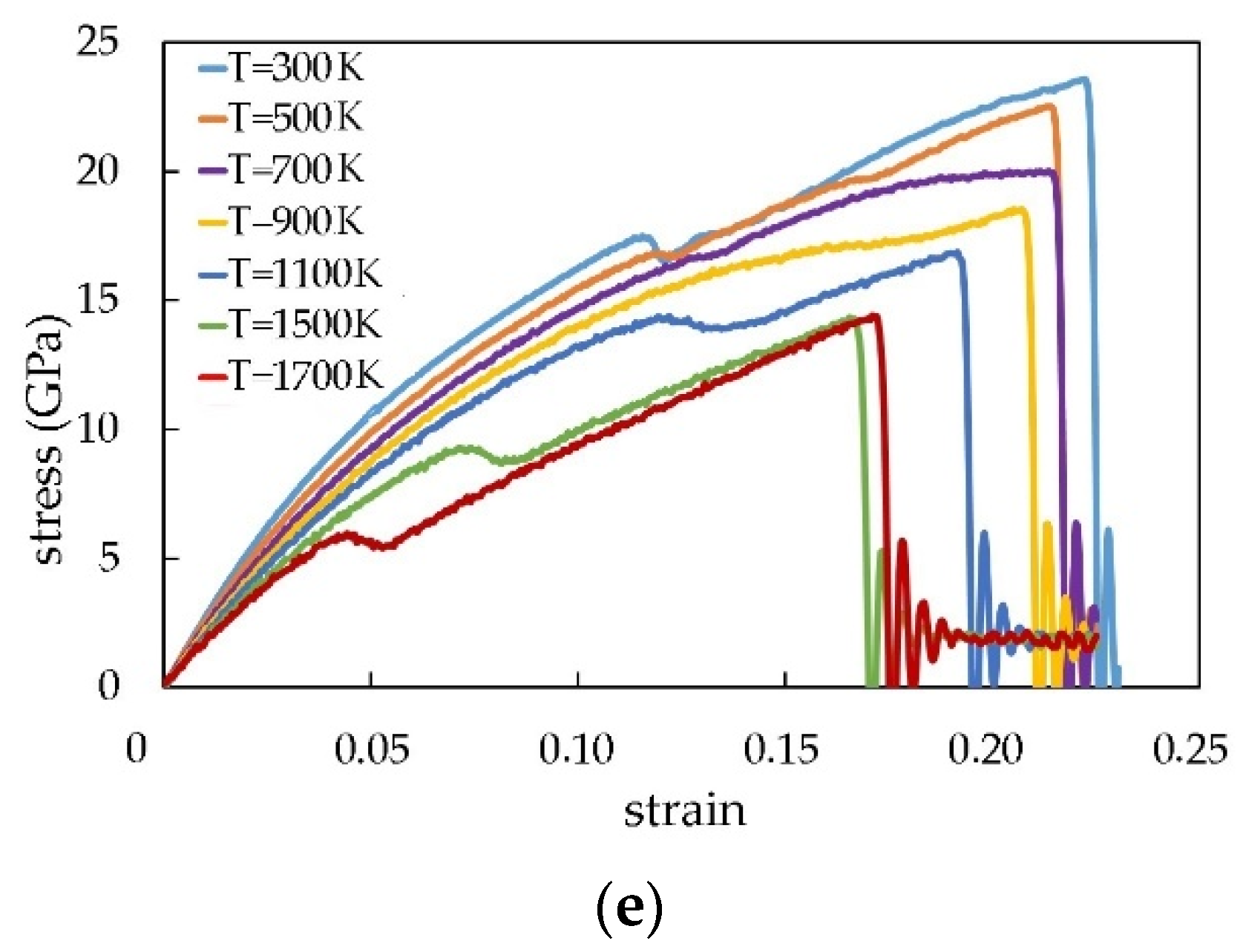
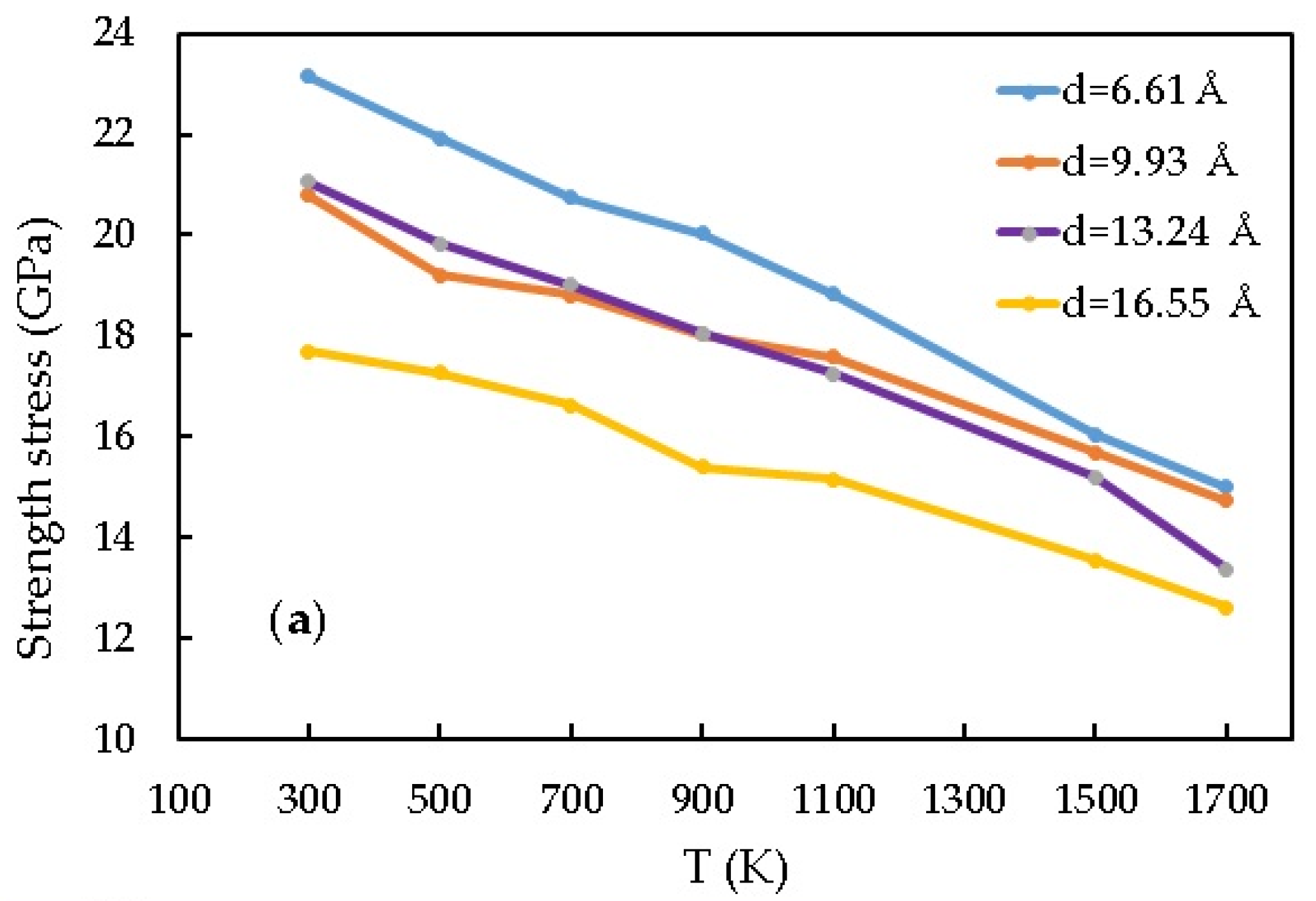
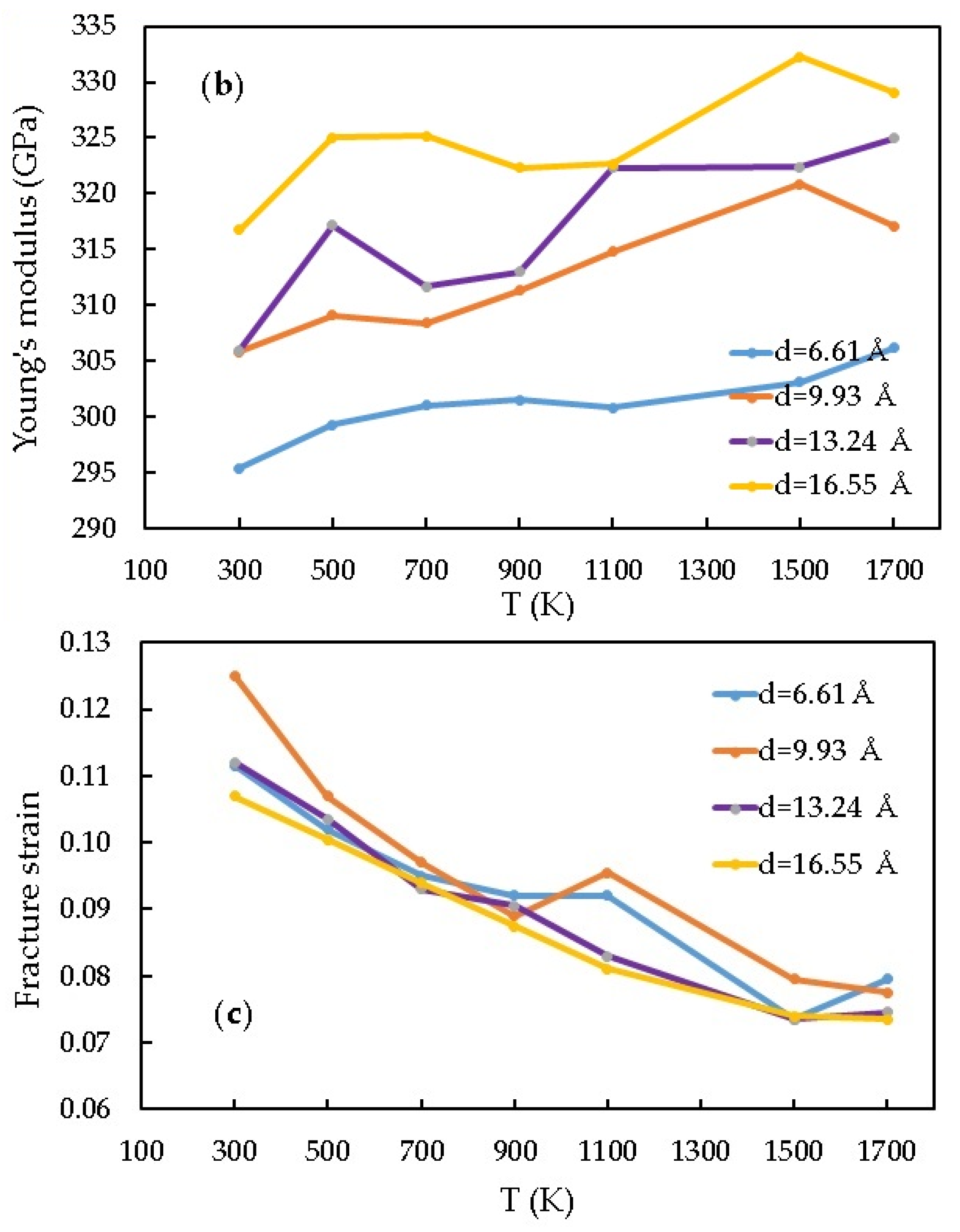
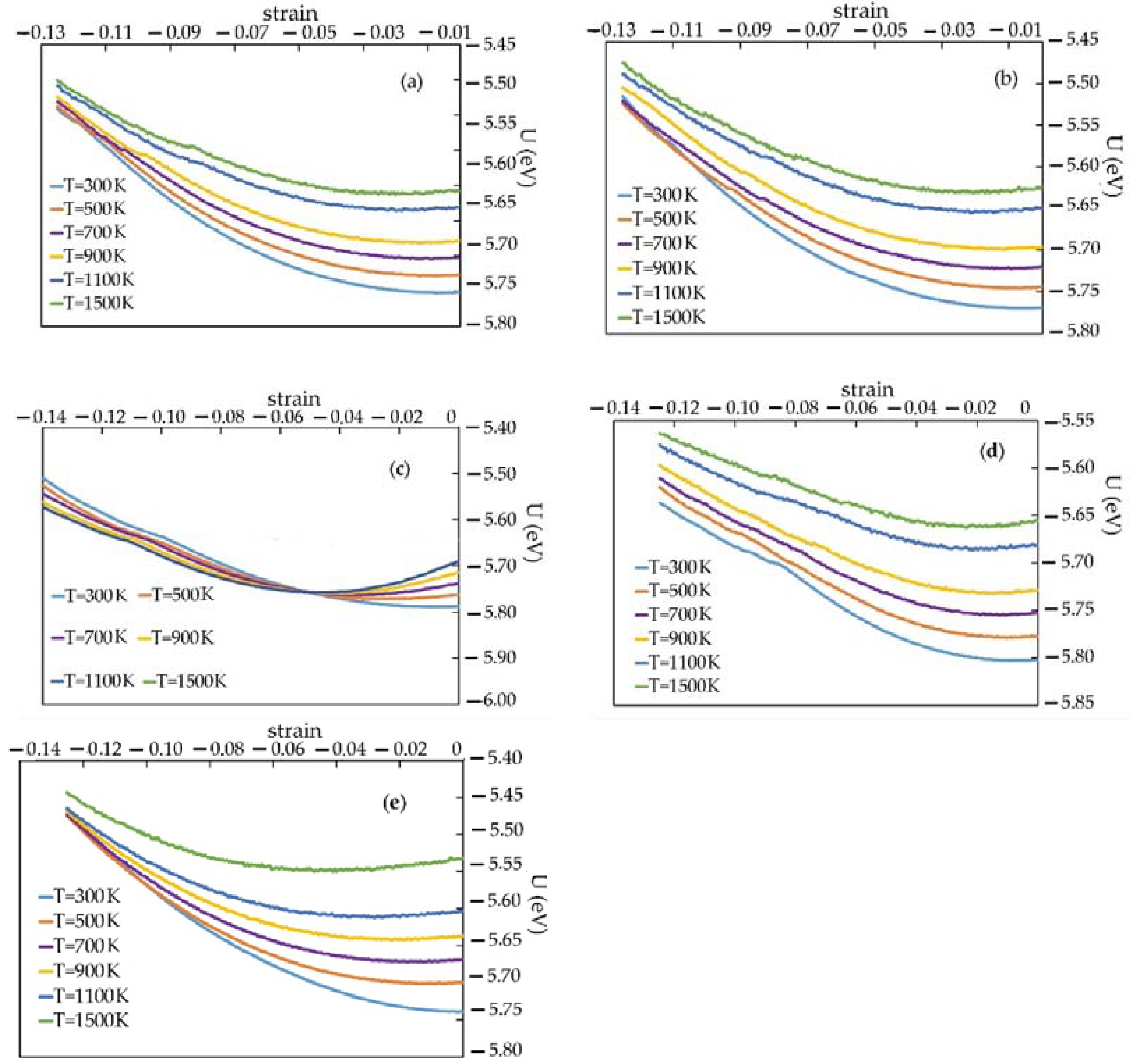

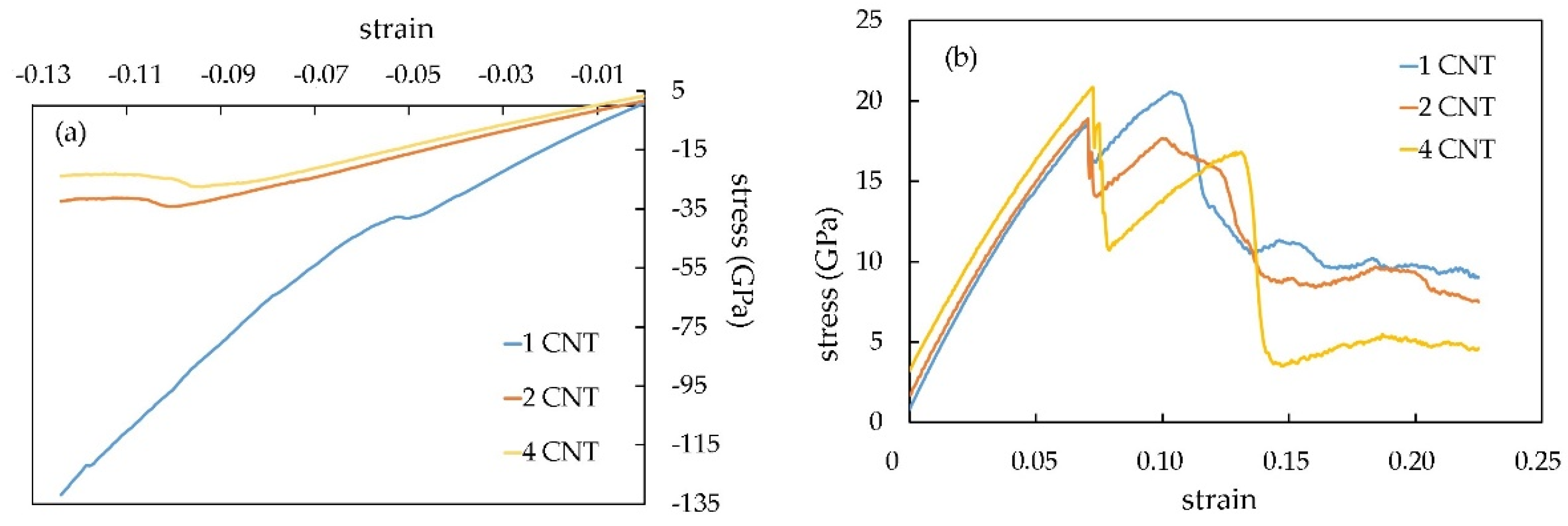



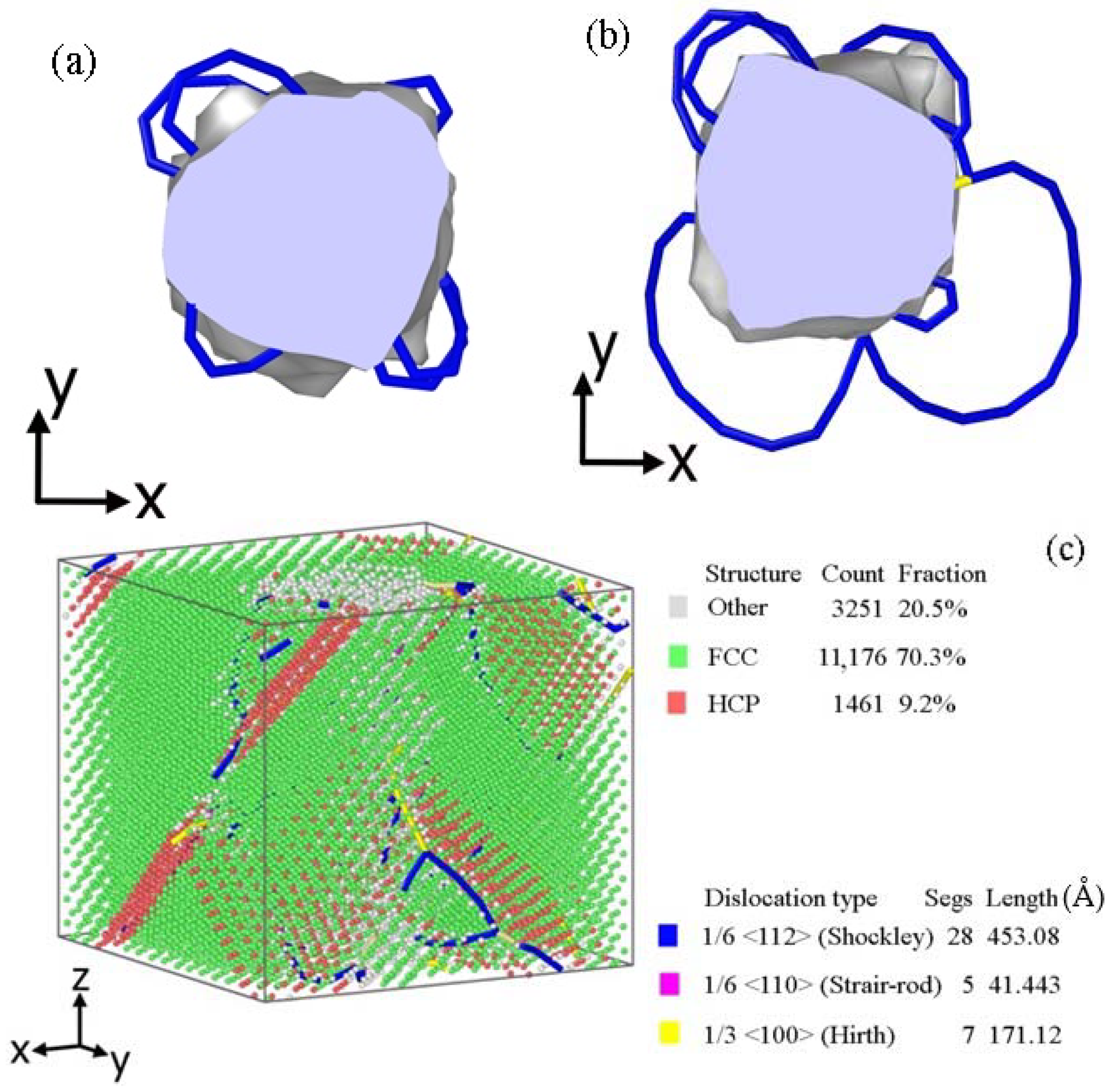
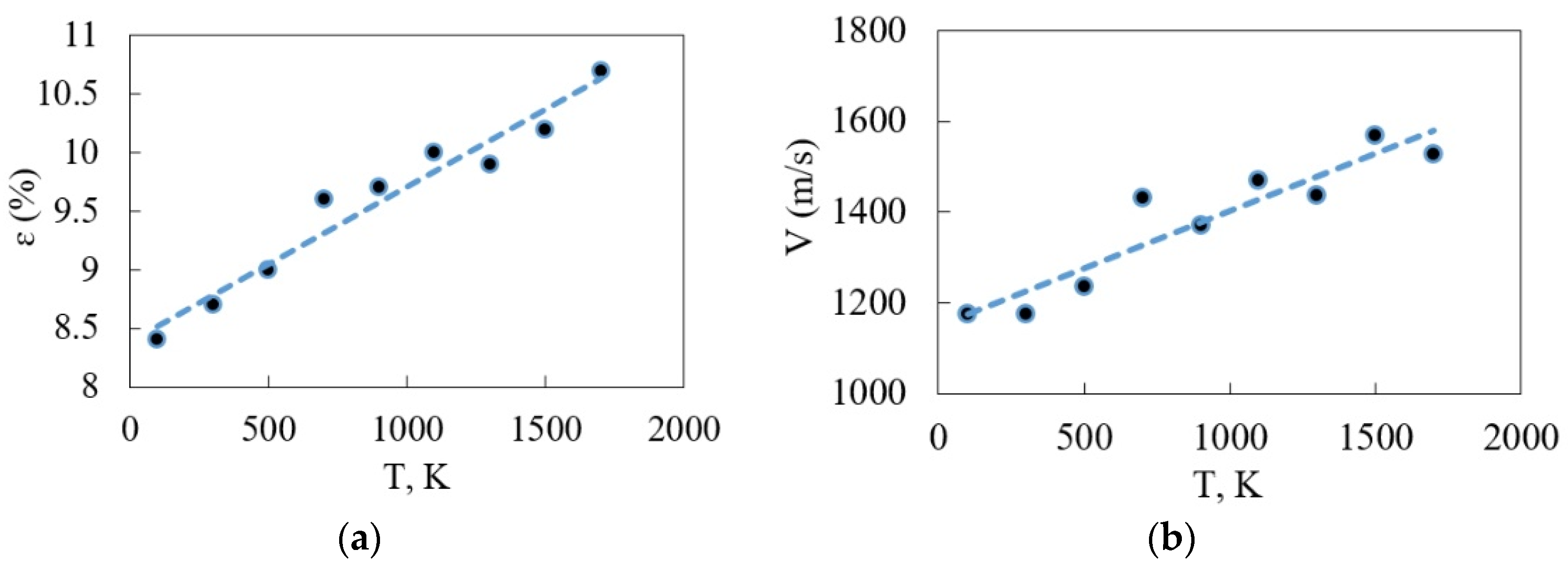

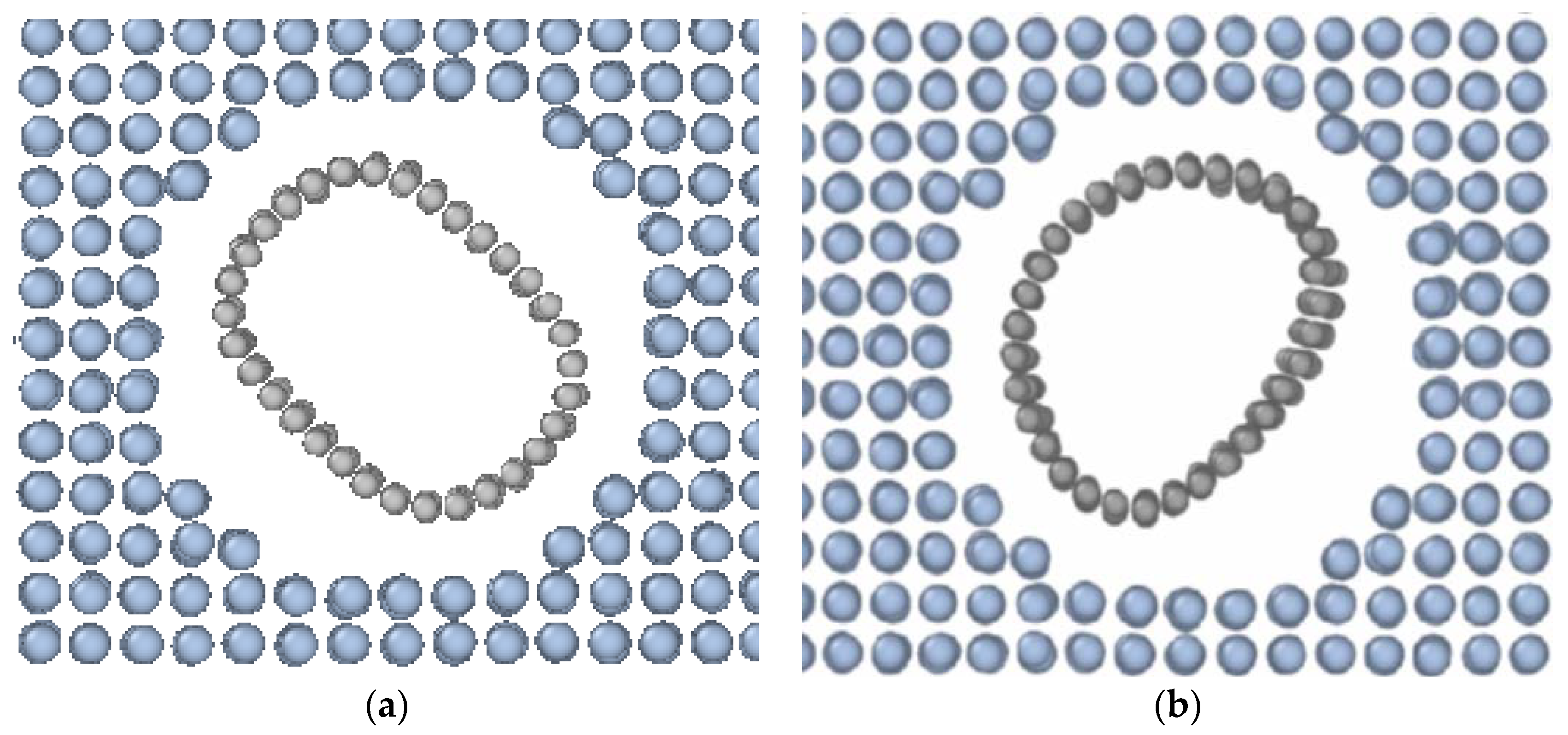
| Model | Volume Fraction of CNT (%) | Mass Fraction of CNT (%) | |
|---|---|---|---|
| Different diameters of CNT (Å) | 6.62 | 2.76 | 0.17 |
| 9.93 | 4.13 | 0.26 | |
| 13.24 | 5.54 | 0.36 | |
| 16.55 | 7.05 | 0.46 | |
| Different quantities of CNT | 1 | 5.54 | 0.36 |
| 2 | 11.2 | 0.77 | |
| 4 | 23.05 | 1.81 |
| CNT Diameter (Å) | T (K) | Young’s Modulus (GPa) | Strength Stress (GPa) | Destruction Deformation (%) | Yield Stress (GPa) |
|---|---|---|---|---|---|
| 6.62 | 300 | 295.42 | 23.15 | 0.11 | 23.11 |
| 500 | 299.28 | 21.93 | 0.10 | 21.54 | |
| 700 | 301.04 | 20.73 | 0.10 | 20.60 | |
| 900 | 301.49 | 20.03 | 0.09 | 18.21 | |
| 1100 | 300.79 | 18.83 | 0.09 | 16.34 | |
| 1500 | 303.10 | 16.05 | 0.07 | 15.64 | |
| 1700 | 306.16 | 14.98 | 0.08 | 11.45 | |
| 9.93 | 300 | 305.83 | 20.79 | 0.125 | 19.61 |
| 500 | 309.08 | 19.20 | 0.107 | 18.76 | |
| 700 | 308.43 | 18.80 | 0.097 | 17.31 | |
| 900 | 311.29 | 18.03 | 0.089 | 17.93 | |
| 1100 | 314.81 | 17.58 | 0.0955 | 17.23 | |
| 1500 | 320.83 | 15.68 | 0.0795 | 15.52 | |
| 1700 | 317.12 | 14.72 | 0.0775 | 14.25 | |
| 13.24 | 300 | 305.98 | 21.06 | 0.11 | 20.50 |
| 500 | 317.18 | 19.82 | 0.10 | 19.64 | |
| 700 | 311.70 | 19.01 | 0.09 | 18.03 | |
| 900 | 313.01 | 18.05 | 0.09 | 17.16 | |
| 1100 | 322.28 | 17.25 | 0.08 | 16.89 | |
| 1500 | 322.40 | 15.19 | 0.07 | 12.76 | |
| 1700 | 324.96 | 13.36 | 0.07 | 9.87 | |
| 16.55 | 300 | 316.76 | 17.69 | 0.107 | 14.32 |
| 500 | 325.01 | 17.27 | 0.1005 | 15.83 | |
| 700 | 325.17 | 16.62 | 0.094 | 13.7 | |
| 900 | 322.31 | 15.39 | 0.0875 | 13.84 | |
| 1100 | 322.70 | 15.15 | 0.081 | 13.69 | |
| 1500 | 332.24 | 13.54 | 0.074 | 8.27 | |
| 1700 | 329.04 | 12.61 | 0.0735 | 12.32 | |
| Pure Pt | 300 | 179.32 | 23.56 | 0.22 | 17.36 |
| 500 | 167.52 | 22.53 | 0.213 | 16.73 | |
| 700 | 158.86 | 20.04 | 0.2135 | 16.7 | |
| 900 | 156.44 | 18.54 | 0.207 | 17.11 | |
| 1100 | 152.52 | 16.88 | 0.1915 | 14.37 | |
| 1500 | 153.31 | 14.36 | 0.1655 | 9.3 | |
| 1700 | 154.07 | 14.44 | 0.171 | 5.8 |
| CNT Diameter (Å) | T (K) | Young’s Modulus (GPa) | Strength Stress (GPa) | Destruction Deformation (%) |
|---|---|---|---|---|
| 6.63 | 300 | 305.12 | 47.23 | 0.11 |
| 500 | 308.14 | 46.10 | 0.10 | |
| 700 | 312.56 | 41.60 | 0.10 | |
| 900 | 314.21 | 37.16 | 0.10 | |
| 1100 | 309.57 | 29.67 | 0.09 | |
| 1500 | 313.25 | 29.28 | 0.07 | |
| 9.93 | 300 | 327.12 | 45.85 | 0.11 |
| 500 | 328.63 | 35.94 | 0.09 | |
| 700 | 331.52 | 30.79 | 0.08 | |
| 900 | 345.12 | 32.81 | 0.09 | |
| 1100 | 350.12 | 28.29 | 0.08 | |
| 1500 | 354.23 | 24.27 | 0.07 | |
| 13.24 | 300 | 325.08 | 37.66 | 0.10 |
| 500 | 327.18 | 35.38 | 0.10 | |
| 700 | 331.40 | 37.49 | 0.11 | |
| 900 | 327.18 | 36.60 | 0.11 | |
| 1100 | 325.52 | 36.30 | 0.11 | |
| 1500 | 325.19 | 24.95 | 0.08 | |
| 16.55 | 300 | 378.62 | 28.26 | 0.09 |
| 500 | 364.13 | 25.88 | 0.08 | |
| 700 | 355.11 | 25.45 | 0.08 | |
| 900 | 344.55 | 21.92 | 0.07 | |
| 1100 | 331.02 | 20.48 | 0.07 | |
| 1500 | 318.14 | 17.31 | 0.06 |
| CNT Number | T (K) | Tension | Compression | ||
|---|---|---|---|---|---|
| Young’s Modulus (GPa) | Strength Stress (GPa) | Young’s Modulus (GPa) | Strength Stress (GPa) | ||
| 1 | 300 | 320.56 | 20.54 | 375.65 | 21.26 |
| 500 | 307.84 | 20.11 | 364.13 | 25.88 | |
| 700 | 316.32 | 14.24 | 355.11 | 25.45 | |
| 900 | 310.01 | 13.12 | 344.55 | 21.92 | |
| 1100 | 317.56 | 14.92 | 331.02 | 20.48 | |
| 1500 | 324.60 | 12.36 | 318.14 | 17.31 | |
| 1700 | 320.78 | 10.36 | 378.62 | 28.26 | |
| 2 | 300 | 329.65 | 20.79 | 327.12 | 45.85 |
| 500 | 313.26 | 20.20 | 328.63 | 35.94 | |
| 700 | 323.43 | 16.43 | 331.52 | 30.79 | |
| 900 | 326.65 | 15.87 | 345.12 | 32.81 | |
| 1100 | 327.94 | 15.07 | 350.12 | 28.29 | |
| 1500 | 353.32 | 13.32 | 354.23 | 24.27 | |
| 1700 | 366.89 | 11.32 | 360.20 | 24.34 | |
| 4 | 300 | 342.02 | 20.83 | 325.08 | 37.66 |
| 500 | 363.19 | 20.47 | 327.18 | 35.38 | |
| 700 | 342.80 | 19.21 | 331.40 | 37.49 | |
| 900 | 352.14 | 17.73 | 327.18 | 36.60 | |
| 1100 | 365.36 | 15.88 | 325.52 | 36.30 | |
| 1500 | 449.99 | 13.51 | 325.19 | 24.95 | |
| 1700 | 430.09 | 11.51 | 324.25 | 23.52 | |
Disclaimer/Publisher’s Note: The statements, opinions and data contained in all publications are solely those of the individual author(s) and contributor(s) and not of MDPI and/or the editor(s). MDPI and/or the editor(s) disclaim responsibility for any injury to people or property resulting from any ideas, methods, instructions or products referred to in the content. |
© 2023 by the authors. Licensee MDPI, Basel, Switzerland. This article is an open access article distributed under the terms and conditions of the Creative Commons Attribution (CC BY) license (https://creativecommons.org/licenses/by/4.0/).
Share and Cite
Yankovaskaya, U.I.; Korznikova, E.A.; Korpusova, S.D.; Zakharov, P.V. Mechanical Properties of the Pt-CNT Composite under Uniaxial Deformation: Tension and Compression. Materials 2023, 16, 4140. https://doi.org/10.3390/ma16114140
Yankovaskaya UI, Korznikova EA, Korpusova SD, Zakharov PV. Mechanical Properties of the Pt-CNT Composite under Uniaxial Deformation: Tension and Compression. Materials. 2023; 16(11):4140. https://doi.org/10.3390/ma16114140
Chicago/Turabian StyleYankovaskaya, Ustina I., Elena A. Korznikova, Sofia D. Korpusova, and Pavel V. Zakharov. 2023. "Mechanical Properties of the Pt-CNT Composite under Uniaxial Deformation: Tension and Compression" Materials 16, no. 11: 4140. https://doi.org/10.3390/ma16114140
APA StyleYankovaskaya, U. I., Korznikova, E. A., Korpusova, S. D., & Zakharov, P. V. (2023). Mechanical Properties of the Pt-CNT Composite under Uniaxial Deformation: Tension and Compression. Materials, 16(11), 4140. https://doi.org/10.3390/ma16114140






